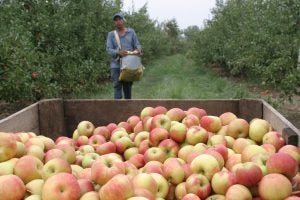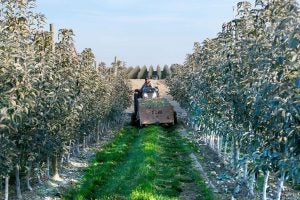Autumn is the season for all things apple. Whether you’re visiting an orchard, drinking apple cider, or making apple pie, apples are a delicious fruit that plays an important role in our diets year round. They’re so popular, in fact, that it’s estimated that the average American eats 16 pounds of fresh apples each year!
Here are some fun facts about apples and how they go from the tree to you:
- It takes a lot to grow an apple. Apple production is time consuming, trees need to grow for anywhere from 4 to 10 years before producing any fruit. It also takes the energy from 50 apple leaves to produce just one apple.
- Apple producers face many challenges when growing apples. Some of the most challenging parts of apple production are weather, disease, insects, and pests. Sudden temperature changes can cause fruit to rot or become sunburned. Droughts or floods can also greatly affect the health of apple trees. There is also a wide variety of diseases that can affect apple trees. Some of these diseases, like flyspeck and sooty blotch, are minimal problems and only cause superficial marks on apples that can be wiped off. Other diseases can cause serious problems and be extremely expensive to control. Some diseases can cause producers to lose trees and even entire orchards! There are apple varieties that are resistant to some diseases, but no apple variety will ever be perfect. Many other insects and pests can cause problems and be both costly and time-consuming to control.

Courtesy of Michigan Farm Bureau - The only variety of apple that is native to the United States is the crabapple, which isn’t even a true apple as we know it! Crabapples don’t refer to one specific variety of apple, instead they are wild apples and tend to be much smaller than the apples we are all familiar with. There are different types of crabapples, but many tend to taste very sour. While they can be eaten and used to make preserves, most people stick with regular apples.
- Washington is the number one apple producing state in the county! Over half of the United States’ apple supply comes from Washington. There are about 1,450 apple growers in the state working orchards on 175,000 acres. Other top states are New York, Michigan, Pennsylvania, California, and Virginia.

Image courtesy of Okanagan Specialty Fruits Inc. - There are more than 7,500 varieties of apples grown around the world, 2,500 of which are grown in the United States. There are also new apple varieties released regularly. Apple breeding programs across the U.S. create some of our favorites, like Honeycrisp and Zestar. Some of 2023’s new varieties include WA 64 from the state of Washington, and Kudos from Minnesota.
- Apples are both delicious and nutritious! Eating one large apple provides 20 percent of the recommended daily value of dietary fiber, 8 percent of your Vitamin C, and 7 percent of your day’s potassium. All that comes with only 130 calories. Research has also found that eating apples can contribute to weight loss, reduce the risk of certain cancers, contribute to good lung and heart health, strengthen the immune system, and provide important antioxidants. Apples truly are a “superfruit.”
- GMO apples? You heard that right! There are currently three approved varieties of genetically modified apples available in the United States and Canada, called Arctic apples. These varieties of apples are meant to resist browning, which can help cut down on food waste! Many people think that brown apples should not be eaten, so by ensuring that Arctic apples don’t brown, less food is wasted. These are the only GMO apple varieties approved today, so any other apples you buy are “Non GMO” — yet, realistically speaking, everything we eat is modified in some way, genetically.
As you can see, there’s a lot more to apples than meets the eye. Apple growing is a difficult job that can take years to come to fruition (literally). They can also be enjoyed in many ways, whether it’s straight from the tree, as apple pie, in a salad, or as apple cider (did you know, it takes around 36 apples to make one gallon of apple cider?). There is also an apple variety for every use, including new varieties each year, genetically modified apples that don’t brown, and even crabapples, which are pretty to look at and tart to eat.
To continue your apple journey, try out some new apple recipes this fall!
Michelle Miller, the “Farm Babe,” is an internationally recognized keynote speaker, writer, and social media influencer and travels full time to advocate for agriculture. She comes from an Iowa-based row crop and livestock farming background and now resides on a timber farm in North Central Florida.





